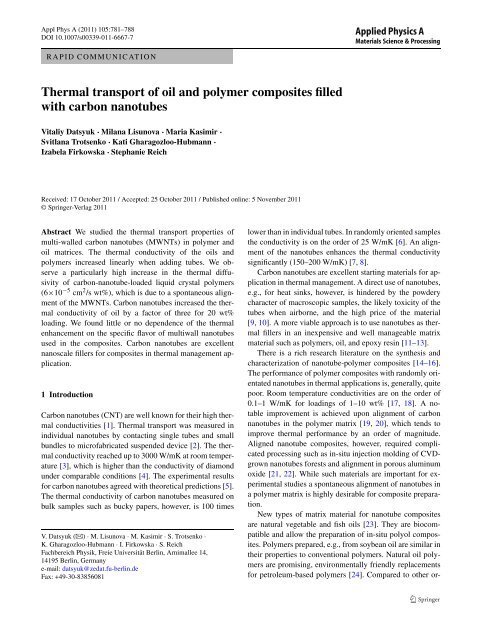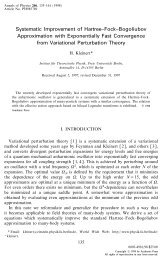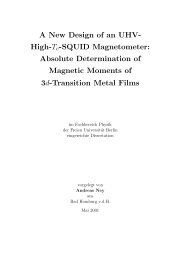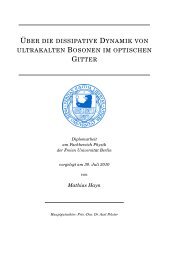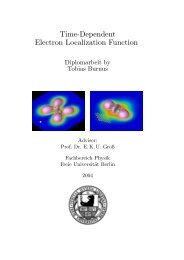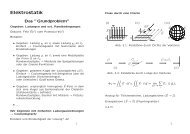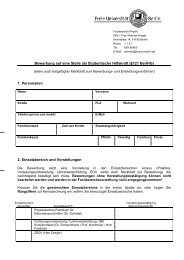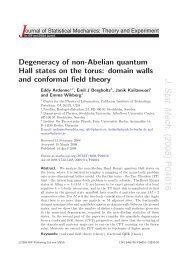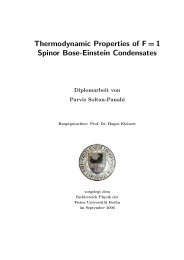Thermal transport of oil and polymer composites filled with carbon ...
Thermal transport of oil and polymer composites filled with carbon ...
Thermal transport of oil and polymer composites filled with carbon ...
Create successful ePaper yourself
Turn your PDF publications into a flip-book with our unique Google optimized e-Paper software.
Appl Phys A (2011) 105:781–788<br />
DOI 10.1007/s00339-011-6667-7<br />
RAPID COMMUNICATION<br />
<strong>Thermal</strong> <strong>transport</strong> <strong>of</strong> <strong>oil</strong> <strong>and</strong> <strong>polymer</strong> <strong>composites</strong> <strong>filled</strong><br />
<strong>with</strong> <strong>carbon</strong> nanotubes<br />
Vitaliy Datsyuk · Milana Lisunova · Maria Kasimir ·<br />
Svitlana Trotsenko · Kati Gharagozloo-Hubmann ·<br />
Izabela Firkowska · Stephanie Reich<br />
Received: 17 October 2011 / Accepted: 25 October 2011 / Published online: 5 November 2011<br />
© Springer-Verlag 2011<br />
Abstract We studied the thermal <strong>transport</strong> properties <strong>of</strong><br />
multi-walled <strong>carbon</strong> nanotubes (MWNTs) in <strong>polymer</strong> <strong>and</strong><br />
<strong>oil</strong> matrices. The thermal conductivity <strong>of</strong> the <strong>oil</strong>s <strong>and</strong><br />
<strong>polymer</strong>s increased linearly when adding tubes. We observe<br />
a particularly high increase in the thermal diffusivity<br />
<strong>of</strong> <strong>carbon</strong>-nanotube-loaded liquid crystal <strong>polymer</strong>s<br />
(6×10 −5 cm 2 /s wt%), which is due to a spontaneous alignment<br />
<strong>of</strong> the MWNTs. Carbon nanotubes increased the thermal<br />
conductivity <strong>of</strong> <strong>oil</strong> by a factor <strong>of</strong> three for 20 wt%<br />
loading. We found little or no dependence <strong>of</strong> the thermal<br />
enhancement on the specific flavor <strong>of</strong> multiwall nanotubes<br />
used in the <strong>composites</strong>. Carbon nanotubes are excellent<br />
nanoscale fillers for <strong>composites</strong> in thermal management application.<br />
1 Introduction<br />
Carbon nanotubes (CNT) are well known for their high thermal<br />
conductivities [1]. <strong>Thermal</strong> <strong>transport</strong> was measured in<br />
individual nanotubes by contacting single tubes <strong>and</strong> small<br />
bundles to micr<strong>of</strong>abricated suspended device [2]. The thermal<br />
conductivity reached up to 3000 W/mK at room temperature<br />
[3], which is higher than the conductivity <strong>of</strong> diamond<br />
under comparable conditions [4]. The experimental results<br />
for <strong>carbon</strong> nanotubes agreed <strong>with</strong> theoretical predictions [5].<br />
The thermal conductivity <strong>of</strong> <strong>carbon</strong> nanotubes measured on<br />
bulk samples such as bucky papers, however, is 100 times<br />
V. Datsyuk (�) · M. Lisunova · M. Kasimir · S. Trotsenko ·<br />
K. Gharagozloo-Hubmann · I. Firkowska · S. Reich<br />
Fachbereich Physik, Freie Universität Berlin, Arnimallee 14,<br />
14195 Berlin, Germany<br />
e-mail: datsyuk@zedat.fu-berlin.de<br />
Fax: +49-30-83856081<br />
lower than in individual tubes. In r<strong>and</strong>omly oriented samples<br />
the conductivity is on the order <strong>of</strong> 25 W/mK [6]. An alignment<br />
<strong>of</strong> the nanotubes enhances the thermal conductivity<br />
significantly (150–200 W/mK) [7, 8].<br />
Carbon nanotubes are excellent starting materials for application<br />
in thermal management. A direct use <strong>of</strong> nanotubes,<br />
e.g., for heat sinks, however, is hindered by the powdery<br />
character <strong>of</strong> macroscopic samples, the likely toxicity <strong>of</strong> the<br />
tubes when airborne, <strong>and</strong> the high price <strong>of</strong> the material<br />
[9, 10]. A more viable approach is to use nanotubes as thermal<br />
fillers in an inexpensive <strong>and</strong> well manageable matrix<br />
material such as <strong>polymer</strong>s, <strong>oil</strong>, <strong>and</strong> epoxy resin [11–13].<br />
There is a rich research literature on the synthesis <strong>and</strong><br />
characterization <strong>of</strong> nanotube-<strong>polymer</strong> <strong>composites</strong> [14–16].<br />
The performance <strong>of</strong> <strong>polymer</strong> <strong>composites</strong> <strong>with</strong> r<strong>and</strong>omly orientated<br />
nanotubes in thermal applications is, generally, quite<br />
poor. Room temperature conductivities are on the order <strong>of</strong><br />
0.1–1 W/mK for loadings <strong>of</strong> 1–10 wt% [17, 18]. A notable<br />
improvement is achieved upon alignment <strong>of</strong> <strong>carbon</strong><br />
nanotubes in the <strong>polymer</strong> matrix [19, 20], which tends to<br />
improve thermal performance by an order <strong>of</strong> magnitude.<br />
Aligned nanotube <strong>composites</strong>, however, required complicated<br />
processing such as in-situ injection molding <strong>of</strong> CVDgrown<br />
nanotubes forests <strong>and</strong> alignment in porous aluminum<br />
oxide [21, 22]. While such materials are important for experimental<br />
studies a spontaneous alignment <strong>of</strong> nanotubes in<br />
a <strong>polymer</strong> matrix is highly desirable for composite preparation.<br />
New types <strong>of</strong> matrix material for nanotube <strong>composites</strong><br />
are natural vegetable <strong>and</strong> fish <strong>oil</strong>s [23]. They are biocompatible<br />
<strong>and</strong> allow the preparation <strong>of</strong> in-situ polyol <strong>composites</strong>.<br />
Polymers prepared, e.g., from soybean <strong>oil</strong> are similar in<br />
their properties to conventional <strong>polymer</strong>s. Natural <strong>oil</strong> <strong>polymer</strong>s<br />
are promising, environmentally friendly replacements<br />
for petroleum-based <strong>polymer</strong>s [24]. Compared to other or-
782 V. Datsyuk et al.<br />
ganic compounds natural <strong>oil</strong>s have a high thermal conductivity<br />
(λ ≈ 0.2 W/mK) [25]. They may also act as binders for<br />
composite samples in thermal management, because the <strong>oil</strong><br />
reduces the porosity <strong>of</strong> a sample. Substituting air molecules<br />
(λair = 0.024 W/mK) in interstitials <strong>with</strong> the thermally better<br />
conducting <strong>oil</strong> will increase the overall performance <strong>of</strong> a<br />
porous composite.<br />
In this paper we report on the thermal <strong>transport</strong> properties<br />
<strong>of</strong> nanotube-<strong>filled</strong> <strong>composites</strong> <strong>with</strong> <strong>polymer</strong>s <strong>and</strong> natural <strong>oil</strong>s<br />
as matrix materials. First, we characterize the thermal properties<br />
<strong>of</strong> <strong>carbon</strong> nanotubes <strong>and</strong> other nanoscale fillers (nanotubes,<br />
graphite, nanodiamond, boron <strong>and</strong> silicon nitride)<br />
after pressing them into macroscopic pellets. The samples<br />
have conductivities well below 1 W/mK. The conductivities<br />
are much lower than the corresponding bulk values, which<br />
is due to the predominance <strong>of</strong> interfaces in the nanoscalepowder<br />
pellets. MWNT-<strong>polymer</strong> <strong>composites</strong> yield a linear<br />
increase in the thermal diffusivity <strong>with</strong> wt% nanotube loading.<br />
At a given nanotube concentration the relative increase<br />
<strong>of</strong> the diffusivity for cellulose acetate as a matrix was more<br />
than three times higher than for PMMA <strong>and</strong> polyimide. The<br />
outperformance <strong>of</strong> CA results from the partial alignment <strong>of</strong><br />
<strong>carbon</strong> nanotubes in this <strong>polymer</strong> because <strong>of</strong> its liquid crystal<br />
behavior. Adding MWNTs to natural <strong>oil</strong>s yield a strong<br />
linear increase in the thermal <strong>transport</strong> coefficient <strong>of</strong> the <strong>oil</strong>.<br />
At 10 wt% MWNT loading we observe a doubling <strong>of</strong> the<br />
thermal diffusivity in soybean <strong>and</strong> olive <strong>oil</strong>.<br />
This paper is organized as follows. In Sect. 2 we discuss<br />
the preparation <strong>and</strong> characterization <strong>of</strong> the samples <strong>and</strong> describe<br />
the measurement techniques. Section 3 contains the<br />
results <strong>of</strong> our study combined <strong>with</strong> a discussion <strong>of</strong> their implication.<br />
In Sect. 4 we summarize our work.<br />
2 Experimental methods<br />
In the present study we use commercially available multiwalled<br />
<strong>carbon</strong> nanotubes. They were industrially produced<br />
<strong>and</strong> purchased from Bayer Materials Science (Baytubes<br />
C150P), Nanocyl (NC7000), Fibermax Composites (Fmax<br />
MWNT). Figure 1 shows an atomic force microscopy<br />
(AFM) image <strong>of</strong> three batches. The tubes were between 5<br />
<strong>and</strong> 40 nm in diameter. Typical length was below 10 micron.<br />
Selected materials parameters are collected in Table 1.<br />
The MWNTs were chemically oxidized <strong>with</strong> acidic oxidation<br />
agents. The samples were refluxed in concentrated nitric<br />
acid (HNO3), as described earlier [26]. To benchmark<br />
the MWNT-based nano<strong>composites</strong> we compared the tubes<br />
to other nanoscale fillers. Nanodiamonds were supplied by<br />
NanoBlox Inc.; boron nitride (BN), silicon carbide (SiC)<br />
<strong>and</strong> silicon nitride (Si3N4) nanoparticles were obtained from<br />
PlasmaChem. The graphite used in our study is GNP-6 supplied<br />
by RMC-Remacon GmbH.<br />
The nanotubes <strong>and</strong> nanoparticles were pressed in pellets<br />
<strong>with</strong> diameters <strong>of</strong> 2.54 cm <strong>and</strong> thickness 0.15–0.18 cm. For<br />
Fig. 1 AFM images <strong>of</strong> multi-walled <strong>carbon</strong> nanotubes purchased from (a) Bayer Materials Science, (b) Nanocyl, <strong>and</strong> (c) Fibermax Composites.<br />
Compare also Table 1<br />
Table 1 Main characteristics<br />
<strong>of</strong> CNTs as specified by the<br />
supplier<br />
MWNT Diameter, Length, Purity, Oxygen content,<br />
(nm) (µm) % %at.<br />
Baytubes 5–20 1–10 95 0.145<br />
NC7000 9.5 1.5 90 0.391<br />
Fmax MWNT 10–40 1–25 93 0.192
<strong>Thermal</strong> <strong>transport</strong> <strong>of</strong> <strong>oil</strong> <strong>and</strong> <strong>polymer</strong> <strong>composites</strong> <strong>filled</strong> <strong>with</strong> <strong>carbon</strong> nanotubes 783<br />
the pressing we used a LaboPress P 200 T (Vogt Maschinenbau<br />
GmbH) under pressure force <strong>of</strong> 200 kN.<br />
For the <strong>polymer</strong> <strong>composites</strong> we used cellulose acetate<br />
(CA), polymethylmethacrylate (PMMA), <strong>and</strong> polyimide<br />
(PI). All <strong>polymer</strong>s were obtained from Sigma Aldrich.<br />
We used two samples <strong>of</strong> CA <strong>with</strong> relative molecular mass<br />
Mr = 29,000 <strong>and</strong> 61,000. The <strong>polymer</strong>s were dissolved in<br />
acetone (10 wt%). One batch <strong>of</strong> <strong>polymer</strong> solution was used<br />
for all <strong>composites</strong>. As a surfactant we sometimes employed<br />
Pluronic ® F-68 (polyoxyethylene–polyoxy-propylene–<br />
polyoxy-ethylene triblock co<strong>polymer</strong>, Sigma Aldrich). The<br />
matrix materials in the <strong>oil</strong> <strong>composites</strong> were soybean, olive<br />
<strong>oil</strong> (Carl Roth GmbH) <strong>and</strong> fish <strong>oil</strong> (Vereinigte Fischmehlwerke<br />
Cuxhaven GmbH & Co KG).<br />
MWNT-<strong>polymer</strong> <strong>composites</strong> were prepared by adding<br />
oxidized MWNTs to the <strong>polymer</strong> solution. This was followed<br />
by ultrasonication for 30 min <strong>with</strong> a Sonopuls<br />
HD3100 (B<strong>and</strong>elin) equipped <strong>with</strong> a cup horn operating at<br />
10 kHz <strong>and</strong> an output power <strong>of</strong> 100 W. The <strong>polymer</strong> <strong>composites</strong><br />
were investigated in liquid (nan<strong>of</strong>luids) <strong>and</strong> solid<br />
form (composite film). Films were cast onto glass substrate<br />
<strong>and</strong> dried under ambient conditions for 48 hours. These<br />
films were than pressed into pellets for the thermal diffusivity<br />
measurement. To study the effect <strong>of</strong> a surfactant on<br />
the nanotube-<strong>polymer</strong> <strong>composites</strong> we dispersed MWNTs in<br />
acetone using Pluronic ® F-68 (2 wt%). The dispersion was<br />
then added to a <strong>polymer</strong> solution <strong>and</strong> treated as described<br />
for the MWNT-<strong>polymer</strong> <strong>composites</strong>.<br />
Composites <strong>of</strong> MWNT <strong>and</strong> natural <strong>oil</strong> were prepared by<br />
adding <strong>carbon</strong> nanotubes into the <strong>oil</strong> followed by sonication<br />
or mechanical treatment <strong>with</strong> a three roll mill (Exakt 80E,<br />
Exact Advanced Technologies GmbH) <strong>with</strong> a gap <strong>of</strong> 15 <strong>and</strong><br />
5 µm, respectively. Similar approach was used for preparation<br />
<strong>of</strong> the Graphite-natural <strong>oil</strong> <strong>composites</strong>.<br />
We characterized our samples by microscopy. The morphology<br />
<strong>of</strong> MWNT, the <strong>polymer</strong> <strong>and</strong> <strong>oil</strong> <strong>composites</strong> was examined<br />
by scanning electron microscopy (SEM, Hitachi S-<br />
4800 <strong>with</strong> a cold FEG). AFM images were obtained <strong>with</strong><br />
a Park AFM.<br />
We measured the thermal properties <strong>of</strong> the starting nanomaterial,<br />
the MWNT-<strong>polymer</strong> <strong>and</strong> MWNT-<strong>oil</strong> <strong>composites</strong>.<br />
For the thermal diffusivity measurements we first prepared<br />
disks <strong>of</strong> 25.4 mm in diameter <strong>and</strong> 5 mm in thickness. They<br />
were measured on a XenonFlash XFA500 (Linseis Messgeräte<br />
GmbH). The flash method deposits a short, intense<br />
energy pulse on one surface <strong>of</strong> the disk. The pulse was generated<br />
by a Xenon lamp <strong>with</strong> maximum energy pulse <strong>of</strong><br />
10 J/pulse. The temperature excursion at the opposite surface<br />
is monitored. The characteristic time dependence <strong>of</strong> the<br />
temperature—the thermogram—allows calculating the thermal<br />
diffusivity according to the Parker equation [27]<br />
α = 0.139L 2 /t1/2, (1)<br />
where L is the sample thickness <strong>and</strong> t1/2 the time for the signal<br />
to reach half <strong>of</strong> its maximum. To measure the diffusivity<br />
<strong>of</strong> liquid <strong>oil</strong> <strong>composites</strong> we placed the sample into a stainless<br />
steel container <strong>with</strong> known thermal diffusivity, specific<br />
heat, <strong>and</strong> density <strong>of</strong> the container material.<br />
From the thermal diffusivity α we calculated the conductivity<br />
λ = αCpρ,<br />
where Cp is the specific heat <strong>and</strong> ρ the density <strong>of</strong> the material.<br />
The specific heat was obtained <strong>with</strong> a Dynamic Scanning<br />
Calorimeter PT1 (Linseis Messgeräte GmbH). We used<br />
aluminum crucibles in air atmosphere <strong>and</strong> a heating rate <strong>of</strong><br />
10°C/min. The specific heat was calculated from the heat<br />
flux <strong>of</strong> the composite samples based on the sapphire st<strong>and</strong>ard.<br />
The bulk density <strong>of</strong> the samples was calculated as the<br />
ratio <strong>of</strong> sample mass to its volume.<br />
We also measured the thermal conductivity <strong>of</strong> our samples<br />
using a HotDisk Transient Plane Source TPS 2500 S<br />
(HotDisk AB). The system uses a nickel wire wound in two<br />
intertwined spirals as a sensor. An electrical pulse <strong>with</strong> a<br />
power 0.03–0.5 W in the nickel generates a heat pulse that<br />
raises the temperature <strong>of</strong> the sample [28]. The nickel wire<br />
is then used as a sensor to measure the heat dissipation.<br />
The HotDisk method requires no special sample preparation.<br />
The sensor is simply placed between two pieces <strong>of</strong><br />
the evaluated materials. All measurements were performed<br />
at 23°C.<br />
3 Results <strong>and</strong> discussion<br />
In this section we present the results <strong>of</strong> the thermal <strong>transport</strong><br />
properties <strong>of</strong> the nanoscale fillers followed by the <strong>polymer</strong><strong>and</strong><br />
<strong>oil</strong>-based MWNT <strong>composites</strong>. The thermal diffusivity<br />
measured on pressed pellets <strong>of</strong> nanoscale fillers are shown<br />
in Fig. 2. The thermal diffusivities <strong>of</strong> the compressed nanomaterials<br />
are several orders <strong>of</strong> magnitude lower than diffusivities<br />
<strong>of</strong> individual nanostructures <strong>and</strong> bulk samples <strong>of</strong> the<br />
same material.<br />
Pressed powders <strong>of</strong> nanoscale materials typically show a<br />
very poor thermal performance, because thermal <strong>transport</strong><br />
becomes dominated by the interfaces. We confirm the low<br />
coefficients <strong>of</strong> thermal <strong>transport</strong> by the independent Hot-<br />
Disk method, see Fig. 3. Similarly low values for the thermal<br />
conductivity were reported for powder-pressed samples<br />
<strong>of</strong> unoriented MWNTs (0.15 W/mK in Ref. [29] <strong>and</strong> 0.25<br />
W/mK in Ref. [30]) <strong>and</strong> graphite (0.2 W/mK, Ref. [31]).<br />
We also note that a Green’s function calculation for an unoriented,<br />
three-dimensional network <strong>of</strong> single-walled <strong>carbon</strong><br />
nanotubes predicted λ = 1W/mK[32]. The setting in<br />
the calculations—atomically identical, straight, defect-free<br />
tubes—certainly serves as an upper bound to our measurements.<br />
Pressed pellets <strong>of</strong> boron nitride nanostructures had
784 V. Datsyuk et al.<br />
Fig. 2 <strong>Thermal</strong> diffusivity <strong>of</strong><br />
nanomaterials measured on<br />
compacted pellets. CNT:<br />
Baytubes, o-CNT: oxidized<br />
Fmax MWNTs, ND:<br />
nanodiamonds, o-ND: oxidized<br />
nanodiamonds, Gr-sm: graphite<br />
<strong>of</strong> submicron size, Gr-µm:<br />
graphite <strong>of</strong> 200 µm size, BN:<br />
boron nitride nanoparticles,<br />
SN (Si3N4): silicon nitride<br />
nanoparticles, SC: silicon<br />
carbide nanoparticles<br />
Fig. 3 <strong>Thermal</strong> conductivity <strong>of</strong><br />
the nanomaterials measured on<br />
compacted pellets by HotDisk<br />
thermal conductivities 0.4–2 W/mK depending on the exact<br />
morphology <strong>of</strong> the nano filler [32]. As for <strong>carbon</strong>-based<br />
materials the powder-pressed pellets <strong>of</strong> BN nanostructures<br />
have a thermal conductivity that is several orders <strong>of</strong> magnitude<br />
lower than in bulk BN (740 W/mK) [33].<br />
Two observations are noteworthy in the thermal diffusivity<br />
<strong>and</strong> conductivity <strong>of</strong> the powder-pressed samples,<br />
see Figs. 2 <strong>and</strong> 3. First, oxidized nanotubes <strong>and</strong> nanodiamonds<br />
show slightly better thermal performance than the asreceived<br />
material. This could be due to a better compaction<br />
<strong>of</strong> the oxidized tubes <strong>and</strong> particles. The measured density<br />
<strong>of</strong> the compacted pellets was 400 <strong>and</strong> 1300 kg/m 3 for asreceived<br />
<strong>and</strong> oxidized MWNTs, respectively. An increase<br />
in density generally increases the contact area per link <strong>of</strong><br />
two nanostructures <strong>and</strong> hence reduced the interface resistance.<br />
Strong increases <strong>of</strong> the network thermal conductivity<br />
<strong>with</strong> increasing density were reported <strong>and</strong> observed experimentally<br />
[31, 34]. The better packing <strong>of</strong> the oxidized<br />
MWNT can be explained by formation <strong>of</strong> dense assemblies<br />
<strong>of</strong> nanotubes that bind together through surface groups during<br />
solvent drying after oxidation, leading to the reduction<br />
<strong>of</strong> the interfacial resistance [35]. Second, we note the much<br />
higher value <strong>of</strong> the thermal diffusivity for the <strong>carbon</strong> nanotubes<br />
in Fig. 2 compared to the spherical nanodiamonds<br />
<strong>and</strong> graphite. It may arise from the higher aspect ratio <strong>of</strong><br />
the nanotubes. The observation is in qualitative agreement<br />
<strong>with</strong> the higher thermal conductivity <strong>of</strong> pellets <strong>of</strong> cylindrical<br />
boron nitride nanotubes (2.2 W/mK) compared to spherical<br />
BN particles (0.9 W/mK) [36].<br />
The HotDisk results also confirm the trend <strong>of</strong> increasing<br />
thermal conductivity by oxidation already observed in the<br />
diffusivities. The highest thermal conductivity <strong>of</strong> the boron<br />
nitride sample despite their comparatively low thermal diffusivity,<br />
Fig. 2, is due to the large specific heat <strong>and</strong> high<br />
density <strong>of</strong> BN compared to MWNTs [36, 37].
<strong>Thermal</strong> <strong>transport</strong> <strong>of</strong> <strong>oil</strong> <strong>and</strong> <strong>polymer</strong> <strong>composites</strong> <strong>filled</strong> <strong>with</strong> <strong>carbon</strong> nanotubes 785<br />
Fig. 4 <strong>Thermal</strong> conductivity <strong>of</strong> MWNT-CA-based nan<strong>of</strong>luids as<br />
a function <strong>of</strong> nanotube contents. Black squares are for Nanocyl, open<br />
triangle for Fibermax, <strong>and</strong> open circles for Baytubes MWNTs. The<br />
lines are linear fits to the data points<br />
We now discuss the thermal properties <strong>of</strong> <strong>polymer</strong>s when<br />
embedding <strong>carbon</strong> nanotubes for increased thermal conductivity.<br />
Nanocyl, FiberMax, <strong>and</strong> Baytubes MWNTs were dispersed<br />
in 10 wt% CA solution in acetone. The thermal diffusivity<br />
was measured as a function <strong>of</strong> MWNT content <strong>and</strong><br />
converted into thermal conductivities, see Fig. 4. There appears<br />
to be a linear dependence <strong>of</strong> the relative thermal conductivity<br />
as a function <strong>of</strong> nanotube loading. The three types<br />
<strong>of</strong> multi-walled nanotube filler result in a similar enhancement<br />
<strong>of</strong> the thermal properties <strong>of</strong> the CA nan<strong>of</strong>luids despite<br />
the variations in tube diameter. A loading <strong>of</strong> 5 wt% multiwalled<br />
<strong>carbon</strong> nanotubes into the CA solution leads to an increase<br />
<strong>of</strong> thermal conductivity by a factor <strong>of</strong> 1.5. Baytubes<br />
nanotubes resulted in a slightly lower enhancement (1.4),<br />
which could be due to the microsized agglomerates Baytubes<br />
are shipped in for safety reasons. The agglomerates<br />
require additional mechanical treatment for a homogeneous<br />
nan<strong>of</strong>luid dispersion, which we did not apply here.<br />
The electrical conductivity <strong>of</strong> most CNT-<strong>filled</strong> <strong>polymer</strong><br />
<strong>composites</strong> varies substantially depending on molecular<br />
weight [38]. We evaluated the effect <strong>of</strong> the <strong>polymer</strong> chain<br />
length on the thermal <strong>transport</strong> properties <strong>and</strong> the presence<br />
<strong>of</strong> a surfactant on the composite thermal diffusivity. The<br />
thermal diffusivity <strong>of</strong> MWNT-CA <strong>composites</strong> <strong>with</strong> 29,000<br />
<strong>and</strong> 61,000 CA molecular weight are shown in Fig. 5(a). No<br />
significant variation in thermal conductivity <strong>of</strong> the MWNT-<br />
CA <strong>composites</strong> <strong>of</strong> the different molecular weight <strong>of</strong> the matrix<br />
<strong>polymer</strong> was observed. Better MWNT dispersion in the<br />
matrix reached <strong>with</strong> surfactant does not affect the thermal<br />
conductivity <strong>of</strong> the MWNT-CA <strong>composites</strong>, see Fig. 5(a).<br />
As alternative matrix materials for the dispersion <strong>of</strong><br />
MWNTs we used polymethyl methacrylate <strong>and</strong> polyimide<br />
resin, Fig. 5(b). Both polyimide resin <strong>and</strong> PMMA as matrix<br />
<strong>polymer</strong>s result in a much lower increase in the thermal conductivity<br />
for a given fraction <strong>of</strong> <strong>carbon</strong> nanotubes compared<br />
to CA. In PMMA <strong>composites</strong> <strong>filled</strong> <strong>with</strong> MWNTs we find a<br />
Fig. 5 <strong>Thermal</strong> diffusivity <strong>of</strong> the MWNT-<strong>polymer</strong> <strong>composites</strong> as<br />
a function <strong>of</strong> MWNT fraction. (a) Comparison between the diffusivities<br />
for CA <strong>with</strong> a molecular weight <strong>of</strong> 61,000 (squares) <strong>and</strong> 29,000<br />
(triangles) as well as MWNTs dispersed in CA <strong>with</strong> 29,000 molecular<br />
weight by a surfactant (circles). (b) Comparison between MWNTs<br />
dispersed in PMMA (closed circles) <strong>and</strong> Polyimide (open circles)<br />
linear increase in the thermal diffusivity <strong>of</strong> (14 ± 2) cm 2 /s.<br />
This is more than a factor <strong>of</strong> two lower than the increase<br />
observed for CA. CA <strong>and</strong> other cellulose derivatives show<br />
liquid crystal properties under specific conditions [39]. The<br />
liquid crystal behavior leads to an alignment <strong>of</strong> the MWNT<br />
[40], which strongly improves thermal <strong>transport</strong> in <strong>polymer</strong>nanotube<br />
networks. We suggest that the higher values <strong>of</strong> the<br />
thermal conductivity in the MWNT-CA <strong>composites</strong> originate<br />
from the MWNT alignment by the cellulose acetate<br />
chains. The orientation <strong>of</strong> the MWNT is also evident in the<br />
SEM pictures <strong>of</strong> the composite as presented in Fig. 6. The<br />
figure shows a cross-section <strong>of</strong> the composite sample where<br />
the majority <strong>of</strong> MWNTs directed perpendicularly to the cut.<br />
For polyimide resin we obtain an increase in the thermal<br />
diffusivity <strong>of</strong> (6 ± 2 × 10 −3 )cm 2 /s, the lowest value <strong>of</strong> the<br />
<strong>composites</strong>, see Fig. 4. The combination <strong>of</strong> polyimide <strong>and</strong><br />
<strong>carbon</strong> nanotubes gives rise to a particularly high interface<br />
resistance, as we explain now. Polyimide resins are widely<br />
used as protective coatings for the metal surfaces [41, 42].<br />
Such coatings show excellent interfacial adhesion, forming<br />
a uniform layer on various surfaces [43]. MWNT-polyimide<br />
<strong>composites</strong> have a structure where individual MWNTs or<br />
their aggregates are encapsulated in a uniform layer <strong>of</strong> polyimide.<br />
Such an interface is the source <strong>of</strong> strong phonon scattering<br />
<strong>and</strong> thereby strongly reduces thermal <strong>transport</strong>.
786 V. Datsyuk et al.<br />
Fig. 6 Scanning electron microscopy image <strong>of</strong> the MWNT-CA composite<br />
<strong>with</strong> 20 wt% <strong>of</strong> Baytubes<br />
Newly emerging matrix materials for nanotube thermal<br />
<strong>composites</strong> are natural <strong>oil</strong>s such as plant <strong>and</strong> fish <strong>oil</strong>s. The<br />
thermal diffusivities <strong>of</strong> MWNTs dispersed in soybean <strong>oil</strong> are<br />
shown in Fig. 7(a). We observe a linear increase in the thermal<br />
diffusivity <strong>of</strong> the <strong>oil</strong> similar to the MWNT-<strong>polymer</strong> solution.<br />
Fibermax tubes perform better than Baytubes in increasing<br />
the thermal diffusivity, which we again attribute to<br />
the tendency <strong>of</strong> Baytubes to form agglomerates. For concentrations<br />
<strong>of</strong> MWNT above 20 wt% the <strong>composites</strong> become<br />
solid. These high-loading <strong>composites</strong> were pressed into pellets<br />
<strong>and</strong> their thermal diffusivity was measured. The results<br />
are presented in Fig. 7(b).<br />
There is a large difference between the extrapolated thermal<br />
diffusivity <strong>of</strong> the fluid samples at 20 wt%<br />
(2 × 10 −3 cm 2 /s) <strong>and</strong> the measured diffusivity <strong>of</strong> the solid<br />
sample at 20 wt% (4.5 × 10 −3 cm 2 /s). We think this is<br />
caused by the change in measurement setup: The solid<br />
samples were measured as pellets <strong>with</strong> the flash method,<br />
whereas the low-concentration liquid samples were placed<br />
in a container <strong>with</strong> known thermal properties, (three-layer<br />
method) see Sect. 2. In three-layer method the heat transfer<br />
from the bottom <strong>and</strong> top <strong>of</strong> the container into the liquid<br />
distorts the measurements <strong>and</strong> might not have been taken<br />
into account properly. Nevertheless, both Fig. 7(a) <strong>and</strong> (b)<br />
confirm the linear dependence <strong>of</strong> the thermal diffusivity on<br />
the MWNT concentration; we also obtain a common slope<br />
<strong>of</strong> the Baytube samples (6 × 10 −5 cm 2 /s wt%) in liquid <strong>and</strong><br />
solid state.<br />
Samples <strong>with</strong> MWNT concentration above 40 wt% do no<br />
longer form well-compacted pellets or f<strong>oil</strong>s. There is an insufficient<br />
amount <strong>of</strong> <strong>oil</strong> to individualize <strong>carbon</strong> nanotubes<br />
given their high specific surface (ca. 150 m 2 /g) [30]. Rather<br />
we obtained a MWNT powder wetted <strong>with</strong> <strong>oil</strong>. Such samples<br />
showed a thermal diffusivity <strong>of</strong> about 6 × 10 −3 cm 2 /s.<br />
This is in agreement <strong>with</strong> the value obtained for the compacted<br />
raw MWNT, compare Fig. 2. We ascribe the further<br />
increase <strong>of</strong> the thermal diffusivity <strong>of</strong> the MWNT-<strong>oil</strong> composite<br />
powder is observed due to the perfect substitution <strong>of</strong><br />
Fig. 7 <strong>Thermal</strong> diffusivity <strong>of</strong> MWNT in soybean <strong>oil</strong>. (a) Fibermax<br />
(<strong>filled</strong> circles) <strong>and</strong> Baytubes (open circles) MWNTs were dispersed in<br />
<strong>oil</strong> <strong>and</strong> measured in a container, see Sect. 2. (b) Solidified MWNT-<strong>oil</strong><br />
<strong>composites</strong> at higher nanotube loading<br />
the air molecules presented in highly porous samples on the<br />
<strong>oil</strong> molecules which have thermal conductivity in one order<br />
<strong>of</strong> magnitude higher compared to air. For highest loading,<br />
Fig. 6(b), we were able to reach the thermal diffusivity <strong>of</strong><br />
oxidized MWNT, Fig. 2, <strong>with</strong>out any chemical treatment.<br />
The influence <strong>of</strong> the type <strong>of</strong> nanoscale filler on the thermal<br />
conductivity <strong>of</strong> the <strong>composites</strong> is presented in Fig. 8.<br />
The figure compares the thermal conductivity <strong>of</strong> MWNTs,<br />
graphite <strong>and</strong> nanodiamonds dispersed in olive <strong>oil</strong> as measured<br />
by the HotDisk technique. The type <strong>of</strong> filler has<br />
a strong influence on the thermal conductivity. The highest<br />
improvement in thermal conductivity is achieved by<br />
MWNTs <strong>with</strong> their particularly high aspect ratio. Again<br />
Fibermax [slope (2.2 ± 0.1) × 10 −2 W/mK] outperform<br />
Baytube nanotubes [(1.6 ± 0.1) × 10 −2 W/mK]. The 40%<br />
stronger increase in the thermal conductivity <strong>of</strong> Fibermax<br />
versus Baytubes olive-<strong>oil</strong> composite is comparable to the<br />
50% steeper increase observed for soybean <strong>oil</strong>, Fig. 7(a),<br />
<strong>and</strong> the 20% difference for the CA <strong>polymer</strong> matrix, Fig. 4.<br />
Graphite powder dispersed in olive <strong>oil</strong> considerably enhances<br />
the thermal conductivity <strong>of</strong> the composite. The slope<br />
[(1.4 ± 0.1) × 10 −2 W/mK at low loading] is comparable<br />
to MWNT. Finally, spherical nanodiamonds only very little<br />
increase the composite thermal conductivity, see Fig. 8.<br />
At 25 wt% <strong>of</strong> MWNT we reached the maximum filler<br />
concentration that was dispersible in the olive-<strong>oil</strong> matrix.
<strong>Thermal</strong> <strong>transport</strong> <strong>of</strong> <strong>oil</strong> <strong>and</strong> <strong>polymer</strong> <strong>composites</strong> <strong>filled</strong> <strong>with</strong> <strong>carbon</strong> nanotubes 787<br />
Fig. 8 <strong>Thermal</strong> conductivity <strong>of</strong> olive-<strong>oil</strong> <strong>composites</strong> <strong>filled</strong> <strong>with</strong> Fibermax<br />
(closed circles) <strong>and</strong> Baytubes (opened circles) MWNTs, graphite<br />
(black diamonds), <strong>and</strong> nanodiamonds (opened squares). Lines are linear<br />
fits to the data. The inset shows the thermal conductivity <strong>of</strong> the<br />
graphite <strong>composites</strong> up to a filler concentration <strong>of</strong> 50 wt%. At high<br />
filler concentration the thermal conductivity increases <strong>with</strong> a three<br />
times larger slope than at low filler content as indicated by separate<br />
fits above <strong>and</strong> below 20 wt% loading<br />
For graphite as a filler, however, we achieved much higher<br />
filler concentrations, see inset <strong>of</strong> Fig. 8. Surprisingly, high<br />
graphite loading yields a very strong improvement in the<br />
thermal <strong>transport</strong> <strong>of</strong> the graphite-<strong>oil</strong> <strong>composites</strong>. An extrapolation<br />
<strong>of</strong> the linear trend at high loading to pure graphite<br />
samples (100% filler concentration) predicts a thermal conductivity<br />
<strong>of</strong> 6 W/mK. This is an order <strong>of</strong> magnitude larger<br />
than the conductivity obtained on pressed graphite pellets,<br />
see Fig. 3. A better morphology might partly explain these<br />
extremely high conductivities. There might also be an alignment<br />
<strong>of</strong> the graphite particles in the composite.<br />
4 Conclusions<br />
In conclusion, we investigated the thermal <strong>transport</strong> <strong>of</strong> <strong>carbon</strong><br />
nanotubes as raw materials <strong>and</strong> as nanoscale fillers in<br />
<strong>polymer</strong> <strong>and</strong> <strong>oil</strong> <strong>composites</strong>. A dispersion <strong>of</strong> nanotubes in<br />
composite filler generally leads to a linear increase <strong>of</strong> the<br />
thermal conductivity <strong>with</strong> increasing content <strong>of</strong> MWNT.<br />
The thermal diffusivity <strong>of</strong> CA loaded <strong>with</strong> 50% MWNTs<br />
increased by a factor <strong>of</strong> two; for PMMA <strong>and</strong> polyimide only<br />
40% increase in the diffusivity was obtained at the same<br />
loading. The better performance <strong>of</strong> CA as a matrix material<br />
is due to the alignment <strong>of</strong> the MWNTs that CA enforces.<br />
Natural <strong>oil</strong>s are another promising matrix material for the<br />
dispersion <strong>of</strong> <strong>carbon</strong> nanotubes. We observe up to tenfold<br />
improvement in the thermal diffusivity <strong>of</strong> soybean <strong>oil</strong> under<br />
extremely high loading <strong>of</strong> MWNTs. A comparison <strong>of</strong> <strong>oil</strong><br />
<strong>composites</strong> using various nanotubes, graphite <strong>and</strong> nanodiamond<br />
showed that nanoscale fillers <strong>with</strong> a high aspect ratio<br />
yield higher thermal conductivities. Similar trends were observed<br />
for pellets <strong>of</strong> raw nanoscale materials.<br />
Acknowledgements We thank G. Weinberg for help <strong>with</strong> the<br />
SEM. We acknowledge financial support by the BMBF under grant<br />
03F01022.<br />
References<br />
1. J.Hone,M.Whitney,C.Piskoti,A.Zettl,Phys.Rev.B59, R2514<br />
(1999)<br />
2. S. Berber, Y.K. Kwon, D. Tománek, Phys. Rev. Lett. 84, 4613<br />
(2000)<br />
3. J. Hone, M. Whitney, A. Zettle, Synth. Met. 103, 2498 (1999)<br />
4. D.G. Onn, A. Witek, Y.Z. Qiu, T.R. Anthony, W.F. Banholzer,<br />
Phys.Rev.Lett.68, 2806 (1992)<br />
5. K. Bi, Y. Chen, J. Yang, Y. Wang, M. Chen, Phys. Lett. A 350, 150<br />
(2006)<br />
6. P. Gonnet, Z. Liang, E.S. Choi, R.S. Kadambala, C. Zhang,<br />
J.S. Brooks, B. Wanga, L. Kramer, Curr. Appl. Phys. 6, 119<br />
(2006)<br />
7. T. Tong, Z. Yang, L. Delzeit, A. Kashani, M. Meyyappan, A. Majumdar,<br />
IEEE Trans. Compon. Packag. Technol. 30, 92 (2007)<br />
8. D. Wang, P. Song, C. Liu, W. Wu, S. Fan, Nanotechnology 19,<br />
075609 (2008)<br />
9. A. Hell<strong>and</strong>, P. Wick, A. Koehler, K. Schmid, C. Som, Environ.<br />
Health Perspect. 115, 1125 (2007)<br />
10. A. Carpinteri, N.M. Pugno, J. Phys., Condens. Matter 20, 474213<br />
(2008)<br />
11. M.J. Biercuk, M. Llaguno, M. Radosavljevic, J.K. Hyun,<br />
A.T. Johnson, J.E. Fischer, Appl. Phys. Lett. 80, 2767 (2002)<br />
12. Y.S. Song, J.R. Yuon, Carbon 43, 1378 (2005)<br />
13. F.H. Gojny, M.H.G. Wichmann, B. Fiedler, I.A. Kinloch,<br />
W. Bauh<strong>of</strong>er, A.H. Windle, K. Schulte, Polymer 47, 2036 (2006)<br />
14. J.N. Coleman, U. Khan, W.J. Blau, Y.K. Gun’ko, Carbon 44, 1624<br />
(2006)<br />
15. A.L. Martínez-Hernández, C. Velasco-Santos, V.M. Castaño, Curr.<br />
Nanosci. 6, 12 (2010)<br />
16. M. Moniruzzaman, K.I. Winey, Macromolecules 39, 5194 (2006)<br />
17. Y.S. Song, J.R. Youn, Carbon 44, 710 (2006)<br />
18. P. Bonnet, D. Sireude, B. Garnier, O. Chauvet, Appl. Phys. Lett.<br />
91, 201910 (2007)<br />
19. B. Pradhan, R.R. Kohlmeyer, J. Chen, Carbon 48, 217 (2010)<br />
20. H. Huang, C. Liu, Y. Wu, S. Fan, Adv. Mater. 17, 1652 (2005)<br />
21. Y. Yao, C. Liu, S. Fan, Nanotechnology 17, 4374 (2006)<br />
22. J.S. Suh, J.S. Lee, Appl. Phys. Lett. 75, 2047 (1999)<br />
23. T. Braun, L. Mark, R. Ohmacht, U. Sharma, Fuller. Nanotub. Carbon<br />
Nanostruct. 15, 311 (2007)<br />
24. V. Sharma, P.P. Kundu, Prog. Polym. Sci. 31, 983 (2006)<br />
25. M. Werner, A. Baars, C. Eder, A. Delgado, J. Chem. Eng. Data<br />
53, 1444 (2008)<br />
26. V. Datsyuk, M. Kalyva, K. Papagelis, J. Parthenios, D. Tasis,<br />
A. Siokou, I. Kalitsis, C. Galiotis, Carbon 46, 833 (2008)<br />
27. W.J. Parker, R.J. Jenkins, C.P. Butler, G.L. Abbott, Appl. Phys.<br />
32, 1679 (1961)<br />
28. J.A. King, R.A. Hauser, A.M. Tomson, I.M. Wescoat, J.M. Keith,<br />
J. Compos. Mater. 42, 91 (2008)<br />
29. R.S. Prasher, X.J. Hu, Y. Chalopin, N. Mingo, K. L<strong>of</strong>green,<br />
S.Volz,F.Cleri,P.Keblinski,Phys.Rev.Lett.102, 105901 (2009)<br />
30. N.R. Pradhan, H. Duan, J. Liang, G.S. Iannacchione, Nanotechnology<br />
20, 245705 (2009)<br />
31. Y. Chalopin, S. Volz, N. Mingo, J. Appl. Phys. 105, 084301<br />
(2009)<br />
32. C. Tang, Y. B<strong>and</strong>o, C. Liu, S. Fan, J. Zhang, X. Ding, D. Golberg,<br />
J. Phys. Chem. B 110, 10354 (2006)<br />
33. G.A. Slack, J. Phys. Chem. Solids 34, 321 (1973)<br />
34. K. Yang, J. He, P. Puneet, Z. Su, M.J. Skove, J. Gaillard, T.M. Tritt,<br />
A.M. Rao, J. Phys., Condens. Matter 22, 334215 (2010)
788 V. Datsyuk et al.<br />
35. M.S.P. Shaffer, X. Fan, A.H. Windle, Carbon 36, 1603 (1998)<br />
36. C. Tang, Y. B<strong>and</strong>o, C. Liu, S. Fan, J. Zhang, X. Ding, D. Golberg,<br />
J. Phys. Chem. B 110, 10354 (2006)<br />
37. A. Simpson, A.D. Stuckes, J. Phys. C, Solid State Phys. 4, 1710<br />
(1971)<br />
38. W.Yi,L.Lu,Z.Dian-lin,Z.M.Pan,S.S.Xie,Phys.Rev.B59,<br />
R9015 (1999)<br />
39. J.N. Coleman, S. Curran, A.B. Dalton, A.P. Davey, B. McCarthy,<br />
W. Blau, R.C. Barklie, Phys. Rev. B 58, R7492 (1998)<br />
40. P. Navard, J.M. Haudin, S. Dayan, P. Sixou, J. Polym. Sci., Polym.<br />
Lett. Ed. 19, 379 (1981)<br />
41. H. Zhang, Z. Wang, Z. Zhang, J. Wu, J. Zhang, J. He, Adv. Mater.<br />
19, 698 (2007)<br />
42. A.M. Wilson, Thin Solid Films 83, 145 (1981)<br />
43. E. Watanabe, K. Kanou, T. Kubota, Electrocomp. Sci. Technol. 8,<br />
15 (1981)


